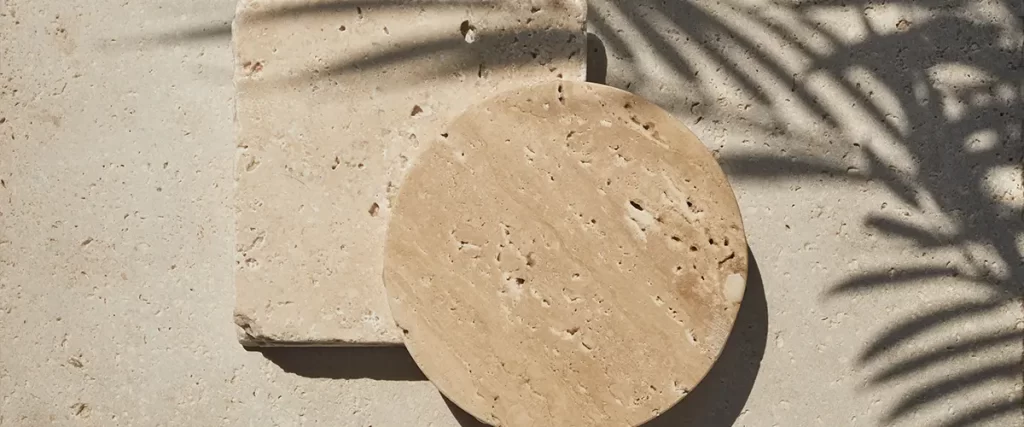Let’s talk about two stunning stones that can elevate the look of your home: travertine and marble. Both are popular choices for flooring, countertops, and other design elements, but they have their own unique vibes. If you’re wondering which one is right for your project, don’t worry—I’ll break it down for you in the simplest way possible.
What is Travertine?
Travertine is a type of natural stone, kind of like marble’s more casual cousin. It’s formed in hot springs and limestone caves, giving it a distinct, textured look. The stone has been used for centuries in everything from Roman baths to modern patios. Its earthy colors and natural texture make it perfect for creating a warm, inviting vibe.
Pros of Travertine
- Earthy and Warm Look: The soft, natural tones like beige, cream, and tan make it versatile and timeless.
- Slip-Resistant: Because of its textured surface, travertine can be less slippery, making it great for outdoor areas or bathrooms.
- Durable: It can last for decades if cared for properly.
- Affordable: Travertine is often less expensive than marble, making it a budget-friendly choice.
Cons of Travertine
- Porous: This stone has tiny holes in it, which means it can absorb liquids and stain easily if not sealed.
- Maintenance: You’ll need to seal it regularly to keep it looking its best.
- Not as Glossy: If you’re after a super polished, shiny look, travertine might feel a bit too rustic.

What is Marble?
Marble is another type of natural stone, but it’s formed under high pressure and heat, which gives it that signature sleek, luxurious look. Marble is known for its veining, where lines of color run through the stone. It’s been a symbol of luxury for centuries—think of ancient Greek statues and Italian palaces.
Pros of Marble
- Elegant and Luxurious: Marble has a polished, high-end appearance that can make any space feel fancy.
- Durability: It’s strong and can withstand heat, making it a great option for kitchens.
- Unique Veining: Every piece of marble is different, so you’ll have a one-of-a-kind look.
Cons of Marble
- Expensive: Marble tends to cost more than travertine, both for the material and the installation.
- High Maintenance: It’s prone to scratching and staining, so you’ll need to seal it regularly and be careful with acidic substances like lemon juice.
- Slippery: When polished, marble can be quite slick, which might not be ideal in bathrooms or around pools.

Where Should You Use Travertine?
Travertine is super versatile, but it really shines in spaces where a natural, cozy vibe is the goal. Here’s where it works best:
- Outdoor Patios: Its slip-resistant surface makes it perfect for areas that get wet, like pool decks or garden paths.
- Bathrooms: It adds a spa-like feel to showers and bathroom floors.
- Living Rooms: Travertine tiles can give your space a warm, rustic charm.
- Fireplace Surrounds: The earthy tones make your fireplace look cozy and inviting.
Where Should You Use Marble?
Marble screams sophistication and works well in places where you want a sleek, polished look:
- Kitchens: Use marble countertops to create a luxurious cooking space. Just be ready to maintain it!
- Bathrooms: For an upscale vibe, marble floors or walls can make your bathroom feel like a high-end hotel.
- Entryways: A marble floor in your entryway makes an unforgettable first impression.
- Accent Walls: Highlight one wall with marble to make a bold design statement.
How Do They Compare in Cost?
Price can be a big factor when choosing between travertine and marble. Generally, travertine is the more affordable option. Here’s a rough idea:
- Travertine: Around $5–$30 per square foot, depending on the quality.
- Marble: Can range from $15–$50 or more per square foot.
Keep in mind, installation costs can also vary. Both materials require professional installation to ensure they last, but marble might cost more because of its weight and fragility.
Maintenance: What You Need to Know
Both travertine and marble require care to keep them looking their best, but there are some differences.
Travertine Maintenance
- Needs regular sealing to prevent stains.
- Clean it with mild, pH-neutral cleaners—avoid anything too acidic.
- Fill in any holes that might develop over time to maintain its durability.
Marble Maintenance
- Seal it regularly to protect against stains and scratches.
- Be cautious with acidic foods or drinks, as they can etch the surface.
- Clean it with soft cloths and specialized marble cleaners.
Durability and Longevity
If properly maintained, both travertine and marble can last a lifetime. However, their durability depends on how you use them.
- Travertine: Its porous nature makes it better suited for areas that don’t get a lot of heavy foot traffic or exposure to harsh chemicals.
- Marble: While it’s strong, it can be prone to scratches and etching, especially in high-use areas.
Aesthetic Differences: Rustic vs. Refined
One of the biggest differences between travertine and marble is their overall look.
- Travertine: Its textured surface and earthy tones make it feel more rustic and natural. It’s perfect if you want your space to feel warm and welcoming.
- Marble: The polished, glossy surface of marble screams elegance and luxury. If you’re going for a sleek, modern look, marble is a clear winner.
Which One Should You Choose?
Now that we’ve gone over the basics, it’s time to think about what’s right for you. Here are some tips:
- Go with travertine if you love natural textures, want a budget-friendly option, and need something slip-resistant for outdoor spaces.
- Choose marble if you’re all about luxury, want a polished look, and don’t mind investing in maintenance.
Both stones are beautiful and durable in their own ways. Your decision will depend on your personal style, budget, and how much maintenance you’re willing to commit to.
Durability and Climate Considerations
Another important factor to consider when choosing between travertine and marble is the climate and environment of your space. Both materials perform differently depending on where you use them.
- Travertine: An excellent choice for outdoor areas due to its porous nature and natural slip resistance. It holds up well in regions with mild climates and doesn’t overheat under the sun, making it perfect for patios, pool decks, and garden paths. However, in regions with harsh winters or freezing temperatures, travertine might struggle. The pores in the stone can absorb water, which expands and cracks when it freezes. Regular sealing can help prevent this.
- Marble: Best suited for indoor applications where temperature fluctuations are less of a concern. Its smooth surface and luxurious appearance make it ideal for kitchens, bathrooms, and dining areas. However, marble can be slippery when wet, so it’s not the best option near tubs or showers.
Cleaning and Maintenance
Cleaning and care routines for travertine and marble differ slightly, but both require regular attention to keep them looking their best.
- Travertine: This material is more forgiving due to its natural texture, which hides small imperfections better than the polished surface of marble. If the sealant wears off or you miss a cleaning spot, it won’t be as noticeable.
- Marble: With its smooth and polished finish, every scratch or stain stands out, especially on lighter colors. Spills, particularly acidic ones like vinegar or lemon juice, need immediate attention to avoid etching or discoloration. Using coasters, placemats, and trivets can go a long way in protecting marble surfaces.
Impact on Resale Value
When it comes to adding value to your home, both travertine and marble can make a significant difference.
- Travertine: Its warm and welcoming look can make outdoor spaces feel more inviting, which is a big selling point for potential buyers.
- Marble: Known for its timeless elegance, marble often increases the perceived value of a home, especially when used in high-end kitchens and bathrooms.
Customization Options
Both travertine and marble allow for plenty of customization, letting you tailor your design to your personal preferences.
- Travertine: Available in finishes like tumbled, honed, or brushed. If you want a rustic look, tumbled travertine is a great choice. For a smoother and more refined finish, honed travertine works beautifully.
- Marble: Offers an impressive range of colors and veining. From classic white Carrara to bold black marbles with gold streaks, marble can easily serve as the centerpiece of any design.
Combining Travertine and Marble
A common question is, “Can I use both travertine and marble in the same space?” The answer is a resounding yes! Mixing the two materials creates a stunning contrast.
For instance:
- Use travertine tiles on the floor for a rustic base.
- Add marble countertops or accents for a touch of luxury.
Combining these materials allows you to enjoy the best of both worlds while creating a layered and dynamic design.
Eco-Friendliness
If sustainability is a concern, both materials have eco-friendly options, though travertine may have a slight edge.
- Travertine: Often sourced locally and requires less energy to process, making it a more sustainable option overall.
- Marble: Responsibly sourced marble from ethical quarries can still be a great choice for environmentally conscious homeowners.
FAQ
Can travertine and marble be used together in one project?
Yes! Combining travertine and marble can create a stunning mix of textures and colors, adding depth and interest to your design.
Which material is more durable?
Both are durable if properly maintained, but marble is harder and less porous, making it slightly more resistant to wear and tear.
Are there budget-friendly options for either material?
Travertine is generally more affordable, but you can find deals on marble remnants or less common colors if you shop around.
What’s the best way to clean these materials?
Use a mild, pH-neutral cleaner and avoid anything abrasive. Regular sealing will also help protect the surface from stains and scratches.
Can I DIY the installation?
It’s best to leave the installation of both travertine and marble to professionals. Proper installation ensures the materials last and perform as expected.

Upgrade Your Home With Land Designs by Colton
Choosing between travertine and marble comes down to your style, budget, and the space you’re designing. If you’re after a warm, natural look with a rustic charm, travertine is a fantastic option. But if you want timeless elegance and a touch of luxury, marble is hard to beat.
At Land Designs by Colton, we specialize in bringing your design dreams to life. Whether you’re leaning toward travertine, marble, or even a combination of both, our team will guide you through every step, from selecting the perfect materials to flawless installation.
Let’s create a space that’s as beautiful as it is functional. Call Land Designs by Colton today at (720) 580-3677 to schedule a consultation and start your project!
